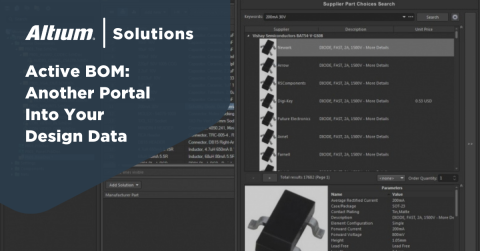Managing Your PCB Design Through BOM Planning: What’s Important
Back in my younger days, I was infatuated with Legos. Every chance I had, I would run into the toy store with a pocket full of change from weekly chores swiping as many sets as I could afford.
Looking back on these days, I’m surprised at how complex these structures were that I (at the ripe age of 8) was actually able to assemble. It never seemed like it was too difficult of a task either.
I never felt incredibly overwhelmed with the procurement and assembly process of these sets, albeit for those pesky sets that were missing that one crucial piece (or when the dog would snag a part or two, oops). Of course, I wasn’t building these sets simply by looking at the box though! Included in each and every set contained step-by-step instructions for the procurement, organization, and assembly of each masterpiece.
Graduating far beyond the golden age of Lego sets, I find myself in a similar situation, except with the big-boy world of PCB design. Toy stores turned into manufacturing pants, Lego blocks turned into components and instruction manuals into PCB design BOM planning. It is truly amazing how directly some of these assembly skills transferred, and now it is time to review what we know about moving production into manufacturing.
PCB Design BOM Planning like Modern Day LEGOs
So how was it that I was able to assemble these complex sets with knowledge extending not much further than basic addition and Power Rangers? The same way that modern-day PCB fab houses create their BOM for their designs. They simply know what is needed, what is not, and how to convey the proper information to the intended audience.
As a kid, I got to consult everything from the dirt to my parents for advice on how to build my contraptions better. As an adult, now I mostly rely on my past knowledge, experience, and the trusted network I’ve developed. Thankfully, there are online resources. Below, you’ll find a checklist of sorts that we’ve assembled (see what I did there?) for you to ask yourself while you embark on the BOM planning path.
Keep Your Audience in Your Head
The first step to creating anything that has information that needs to be conveyed (i.e. anything ever) is to know the audience you are presenting to. As an 8-year-old fart, I had an extremely limited range of knowledge. The instruction manuals I’d read would always cater to this fact.
The information included in these manuals would have to reach a nice Goldilocks zone. Too much information and you run the risk of overloading these poor brains. Too little and you’ll leave them confused and crying in a corner.
The same should be applied to your PCB BOM planning. Who is going to be reading your bill? Is it a design engineer who will just require the system-level components in order to design or verify the schematic? Is it a manufacturer who will need to know every part (down to the board material and fasteners) that is needed to assemble the PCB? Or could it even be a kid who somehow is needed in your design chain?
Segment the intended audience based on the BOM variant they’ll need.
Safely, I think we can assume that these kids would rather be picking their boogers over taking part in PCB design BOM planning, leaving us with an audience of well-educated PCB professionals. This assumption can allow us to then fall back on the practice of when in doubt include more than enough information rather than not enough.
However, packing your full of all the info under the sun can potentially slow up any level of the chain as they’ll have to spend long hours sifting through irrelevant info. Finding that Goldilocks zone will allow for very smooth and effortless processing from each level you send to.
Choices: Flat vs Hierarchical
Depending on the complexity of the design, you’ll likely need to consider a hierarchical style. With the massive Lego sets I took on, this took on the form of sub-assemblies (child) that were listed first, then after, bringing them together into one larger (parent) assembly.
Similarly, in your complex PCB design, understanding when to utilize a parent-child type will, again, be factored out by who is looking at the bill.
Design engineers typically will benefit from a flattened (non-hierarchical) where each part is given the same level of priority to make it easier to manipulate the design from a system level as a whole. Manufacturing engineers, on the other hand, might benefit more from these multi-leveled, parent-child BOMs knowing that these sub-assemblies could require a different level of priority, therefore a different style of manufacturing, in the grand scheme of the build.
Whatever the case may be, and as stated as a spoiler above (sorry about that), you’ll highly benefit from more than just a single variant of your BOM, rather a handful of variants that will cater to each leg of the build process. Each will reflect the same information given, simply in a different format for the intended receiver.
Knowing when to use a hierarchical BOM and when to use a flattened design could save your engineers time and money.
BOM Management Considerations
Additionally worth mentioning, aside from information inclusion, is the management style that you’ll employ in BOM planning. Since you’ll more than likely be managing a handful of different variants that all reflect the same information, imagine the hassle that you’ll face when you change even just a single part.
How many variants will you need to then change (and in the right format)? And what would happen if you goofed on even a single bit of part info? What verification method would you then have to incorporate? How much time (i.e. money) will each change take? What’s the risk involved in your methods? The questions certainly pile on quickly, don’t they?
Obviously, there are plenty of companies that are using archaic pen and paper management systems, and some are even thriving off of it! However, with the advancement of our worldly technology, the use of electronic BOM variation management software makes BOM planning, management, and verification a piece of the cake. With just a few keystrokes, each part change will reflect throughout your entire BOM ecosystem trickling down to each of the intended receivers leaving old-time errors of missed information a thing of the past.
Learning from the golden age of Lego assembly, we can confidently know that when conveying information across a production ecosystem, understanding the intended audience, creating multiple variants for these respective audiences, and utilizing proper electronic BOM variation management and verification methods, we’ll be well on our way to creating a BOM plan that gives us exactly what is needed and also what isn’t.
Utilizing great software features such as Altium’s Active BOM can leave you sleeping peacefully at night knowing that even late-stage design changes will be effortlessly managed and verified with just a few clicks.
If Altium’s Active BOM planning sounds like the right solution for your PCB BOM management problem, or if you are wanting to further discuss BOM planning information inclusion, talk to an Altium expert today.










